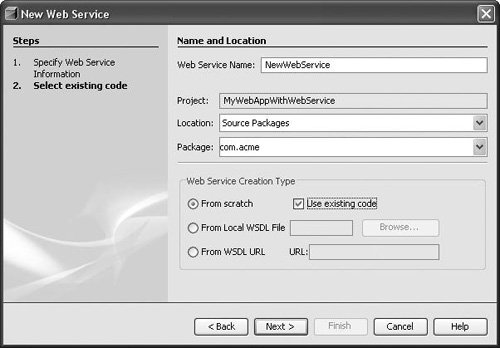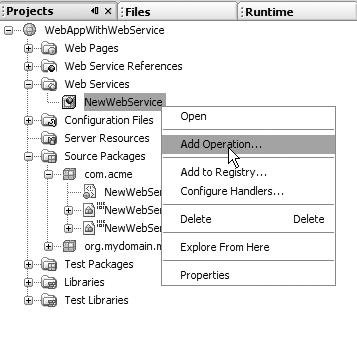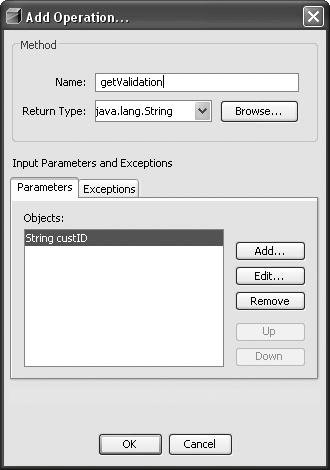Implementing a Web Service in a Web Application
| In the IDE, you can create a web service by implementing an existing WSDL file, exposing existing code, or creating one from scratch. The IDE generates deployment information in the deployment descriptors, the necessary Java code that describes this web service (the default implementation; the Service Endpoint Interface, also called SEI; and a compilation target in the Ant build script). A simple way to create a web service is to start from scratch. Creating a Web ServiceTo create a new web service:
When you complete the wizard, a new web service with no operations is added to your project. You can see a logical node representing this new component in the Web Services node in the Projects window. A new servlet entry is added to the web.xml file, and a webservice-description enTRy is added in the webservices.xml description file (a sibling of the web.xml file). Most of the time, you don't need to worry about these entries, as they are automatically updated by the IDE when necessary. As a developer, you will use the Projects window most (as opposed to the Files window). It synthesizes the implementation details of a web service (such as its implementation class and its SEI) and allows you to:
Adding an OperationChoose Add Operation (either by right-clicking the web service's node in the Projects window, as shown in Figure 12-7, or by right-clicking within the web service in the Source Editor). In the Add Operation dialog box (shown in Figure 12-8), you can configure the list of parameters for this operation, as well as the return type and any exceptions. Figure 12-7. Adding an operation to a web service Figure 12-8. Add Operation dialog box The operation is added to the Java class implementing the web service (see Figure 12-9). The IDE automatically synchronizes the SEI, so you need to concentrate only on developing the operation method body. Figure 12-9. Adding an operation to a web service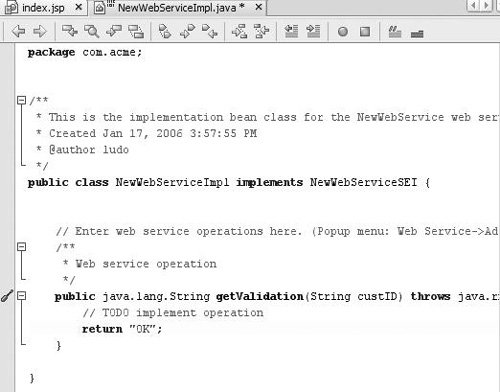 Compiling the Web ServiceNow that the web service has been added to your web application project, you just need to call the Build Project or Deploy Project command (available by right-clicking the project's node) to trigger an Ant build process that will invoke the wscompile tool with the correct parameters. The web application will be packaged as a WAR file and deployed to the target server for this project. Following is an example of what the Ant output might look like (keeping in mind that by default the lines do not wrap they way they do in this excerpt): init: deps-module-jar: deps-ear-jar: deps-jar: wscompile-init: Created dir: C:\ludo\WebAppWithWebService\build\web\WEB-INF\wsdl Created dir: C:\ludo\WebAppWithWebService\build\web\WEB-INF\classes Created dir: C:\ludo\WebAppWithWebService\build\generated\wsclient Created dir: C:\ludo\WebAppWithWebService\build\generated\wsservice Created dir: C:\ludo\WebAppWithWebService\build\generated\wsbinary GoogleSearch-client-wscompile: Copying 1 file to C:\ludo\WebAppWithWebService\build\generated\wsclient\wsdl warning: Processing WS-I non conforming operation "doGetCachedPage" with RPC-Style and SOAP-encoded warning: Processing WS-I non conforming operation "doSpellingSuggestion" with RPC-Style and SOAP-encoded warning: Processing WS-I non conforming operation "doGoogleSearch" with RPC-Style and SOAP-encoded web-service-client-generate: Copying 1 file to C:\ludo\WebAppWithWebService\build\web\WEB-INF Created dir: C:\ludo\WebAppWithWebService\build\web\META-INF Copying 1 file to C:\ludo\WebAppWithWebService\build\web\META-INF Copying 5 files to C:\ludo\WebAppWithWebService\build\web Copying 2 files to C:\ludo\WebAppWithWebService\build\web library-inclusion-in-archive: library-inclusion-in-manifest: web-service-client-compile: Compiling 12 source files to C:\ludo\WebAppWithWebService\build\web\WEB INF\classes Compiling 3 source files to C:\ludo\WebAppWithWebService\build\web\WEB INF\classes Copying 1 file to C:\ludo\WebAppWithWebService\build\web\WEB-INF\classes NewWebService_wscompile: command line: wscompile "C:\Program Files\Java\jdk1.6.0\jre\bin\java.exe" -classpath "C:\Program Files\Java\jdk1.6.0\lib\tools.jar;C:\Sun\AppServer82\lib\j2ee.jar;C:\Sun \AppServer82\lib\saaj-api.jar;C:\Sun\AppServer82\lib\saaj impl.jar;C:\Sun\AppServer82\lib\jaxrpc api.jar;C:\Sun\AppServer82\lib\jaxrpc impl.jar;C:\ludo\WebAppWithWebService\build\web\WEB-INF\classes" com.sun.xml.rpc.tools.wscompile.Main -d "C:\ludo\WebAppWithWebService\build\generated\wsbinary" -define- features:documentliteral,strict,useonewayoperations -keep -mapping "C:\ludo\WebAppWithWebService\build\web\WEB-INF\NewWebService- mapping.xml" -nd "C:\ludo\WebAppWithWebService\build\web\WEB-INF\wsdl" -s "C:\ludo\WebAppWithWebService\build\generated\wsservice" -verbose Xprintstacktrace "C:\ludo\WebAppWithWebService\src\java\com\acme\NewWebService config.xml" [creating model: NewWebService] [creating service: NewWebService] [creating port: com.acme.NewWebServiceSEI] [creating operation: getValidation] compile: compile-jsps: Created dir: C:\ludo\WebAppWithWebService\dist Building jar: C:\ludo\WebAppWithWebService\dist\WebAppWithWebService.war do-dist: dist: run-deploy: Incrementally deploying WebAppWithWebService_localhost:4848_server Completed incremental distribution of WebAppWithWebService Trying to create reference for application in target server completed successfully Trying to start application in target server completed successfully Deployment of application WebAppWithWebService completed successfully run-display-browser: Browsing: http://localhost:8080/WebAppWithWebService/ run: BUILD SUCCESSFUL (total time: 10 seconds) You can use a web browser (as shown in Figure 12-10) to query the deployed and running web application for the published WSDL file for this web service. In this case, the file is http://localhost:8080/WebAppWithWebService/NewWebService?WSDL. Figure 12-10. Web browser displaying the WDSL file for the web service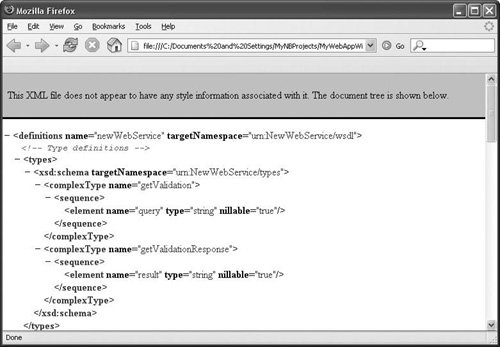 Your web service is now published and available to anyone so that other applications (Java enterprise applications, .NET applications, or Java ME applications) can interoperate with its operations. Creating Web Services from WSDLYou can also create a web service from a WSDL document. A typical scenario when this is necessary is when business partners formulate the way they will communicate in web services. The "contract" between them would be the WSDL, in which they would agree on the data and messages that will be exchanged, as well as on how these messages will be sent and received. Then this WSDL is used to implement the web service. The elements of a WSDL document can be categorized into abstract and concrete parts. The types, message, and portType elements describe the data that form the messages sent and received by web services and clients, as well as the operations that will use these messages. These sections constitute the abstract portion of the WSDL. The binding and service elements describe the protocols and transport mechanisms used to send and receive the messages, as well as the actual address of the endpoint. This is considered to be the concrete portion of the WSDL file. When you are creating a web service from a WSDL in the IDE, a new WSDL is created and packaged with the web service. The abstract portion of the original WSDL is copied to the new one. The concrete portion of the original WSDL is normalized for SOAP binding. Because the JAX-RPC runtime that is used in the NetBeans IDE only supports SOAP over HTTP binding, the WSDL is searched for the first occurrence of this binding. If found, it is copied into the new WSDL. If not, a SOAP/HTTP binding is created for the first portType defined in the original WSDL. Thus, the web service created from WSDL in the NetBeans IDE will always have exactly one SOAP binding and one service port corresponding to that binding. The service element that is added will be named according to the web service name specified in the wizard, replacing the service element in the original WSDL. To create a web service from a WSDL file, click the From Local WSDL File radio button or the From WSDL URL radio button in the wizard, depending on the source of the WSDL document. When the web service is created, classes for the service endpoint interface and implementation bean will be created. These classes will contain all the operations described in the WSDL. The implementation bean class will be displayed in the Source Editor, and you may then enter code to implement these operations. If the WSDL file describes operations that use complex types, classes for these types (known as value types) are also generated so that you may use them in your implementation code. Because the WSDL document governs the interface to the web service, you may not add new operations to web services that are created from a WSDL, because these operations will not be reflected back in the WSDL. Note that WSDLs that import other WSDLs are not supported by this facility.
|
EAN: N/A
Pages: 279
